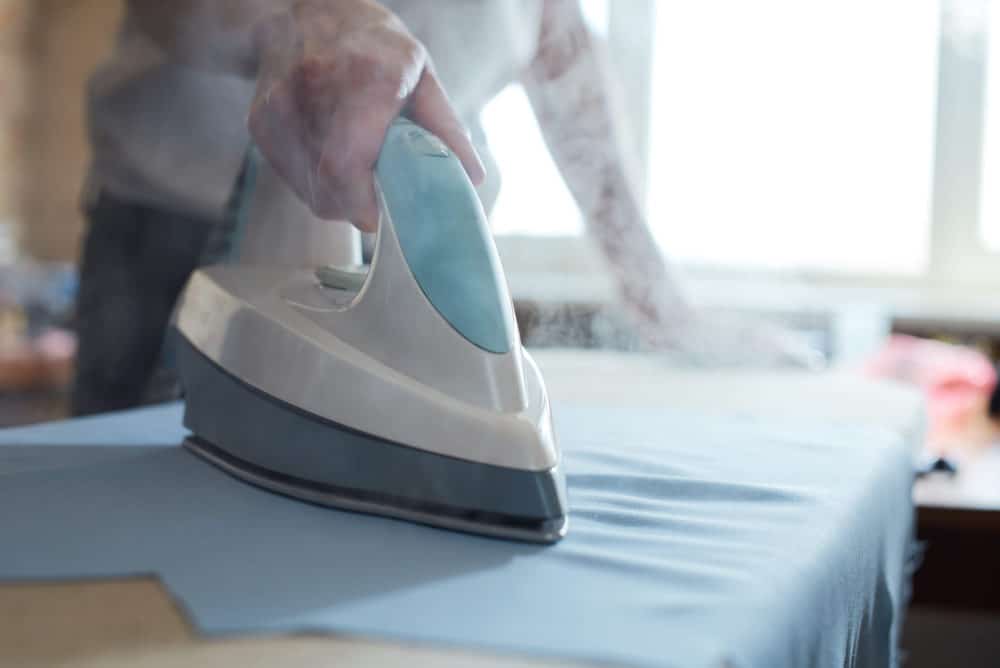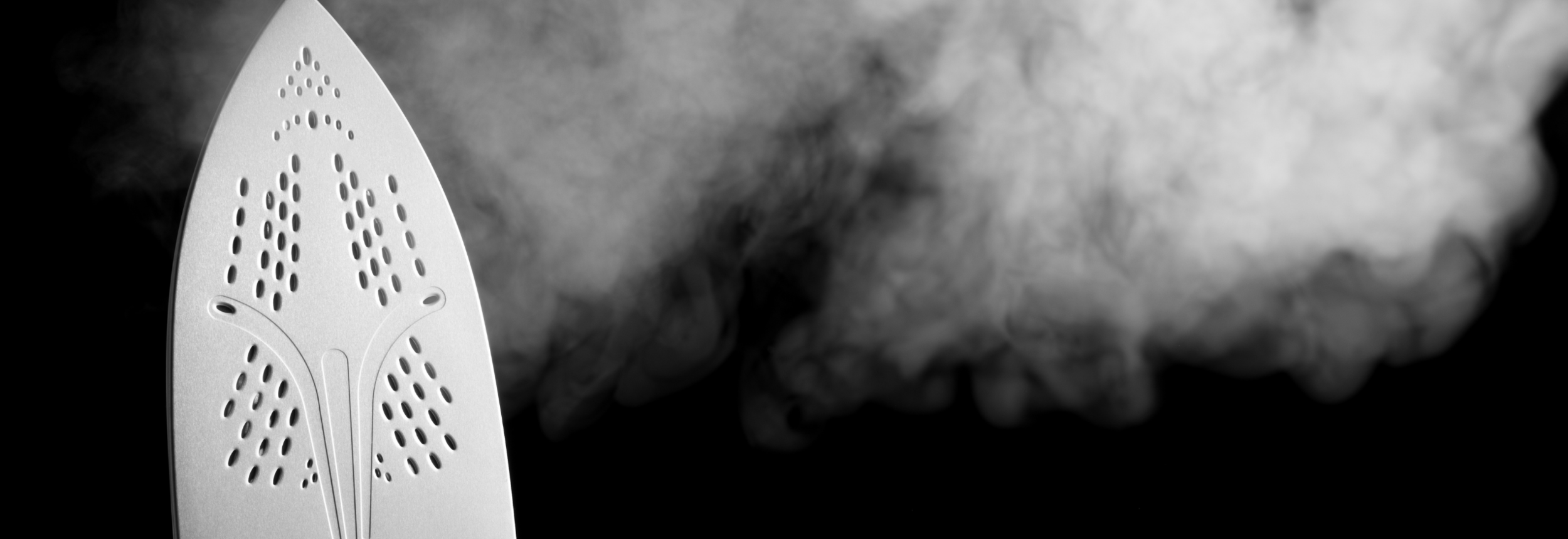Last Updated on November 30, 2023 by Erik Sullivan

An old saying goes, “a man is known by his dress and address”. That means, your dress plays a vital role to enhance your personality.
So, it’s crucial to maintain a crisp and sharp clothes in any meetings and parties. A clothes iron can help you keep your outfit look their best.
But, what types of iron would be best for your clothing? Dry iron vs steam iron?
In this article, I’ll compare both of the laundry tool in side by side by all aspects. Besides that, I’ll also highlight their positives and negatives. Lastly, I’ll briefly answer all of the related queries which are worth a look.
Table of Contents
What is A Dry iron?

A dry iron is a traditional household appliance that has been used for a long time to press garments. These irons generate heat (up to 182 °C) that transfer into the clothes to remove wrinkles and creases. Generally, a dry iron is used for pressing thicker fabrics.
Dry irons feature a solid aluminum soleplate. They require no water source so they can be used anywhere.
Since, dry irons have no water tank so, they’re more lightweight than a steam iron. They are also more budget friendly than their counterpart. However, dry irons are not suitable for delicate items as the intense heat can cause damage to the fabric.
What is A Steam iron?

A steam iron is the upgraded version of traditional dry iron. Instead of using heat, a steam iron convert water into high temperature steam that helps to soften fabric and remove wrinkles. A steam iron contains water in a large water reservoir.
Besides that, they feature ceramic soleplate with so many steam holes. When you press the trigger, the machine release steam through these holes. Most steam irons have a variable temperature control setting so that you can adjust the heat according to the type of fabric you are pressing.
Side By Side Comparison Between Steam Iron And Dry Iron?
Weight: A steam iron is typically heavier than a dry iron, since it contains a water reservoir. This can make it more difficult to maneuver around fabric, especially if you’re working with delicate materials. However, with a heavy steam iron you don’t need to put much pressure on clothes while ironing.
Temperature: A classical dry iron operates at a higher temperature than a steam iron, which means it can remove more stubborn wrinkles quickly and easily. However, this also means that there’s a greater risk of burning your fabric if you’re not careful.
Spray Mist: A steam iron comes with a built-in spray mist, which is quiet useful to dampen your fabric before ironing. This can be a great way to get rid of deep wrinkles. On the flip side, dry iron has no spray mist feature. Therefore, you’ll need to manually moisten your cloth before pressing.
Soleplate Design: The soleplate of a steam iron is not flat as like a traditional dry irons. It contains couple of hundred steam holes. This allows steam to easily come out from the iron when you press the steam button.

Versatility: A steam iron is more versatile than a dry iron. It can be used for more than just ironing clothes. You can also use it to steam curtains, drapes, and upholstery.
Cleaning and maintenance: A steam iron requires more cleaning and maintenance than a dry iron. This is because the water reservoir needs to be emptied after each use, and it must be descaled on a regular basis to prevent mineral buildup.
Ease of use: A dry iron is generally easier to use than a steam iron, since you don’t have to worry about adding water to the reservoir. The lightweight design of a dry iron also makes them a preferred choice of many people.
Cost: Steam irons tend to be more expensive than dry irons, since they offer more features and capabilities. However, this doesn’t mean that they’re not worth the investment – especially if you do a lot of ironing.
Now that you know the key differences between steam irons and dry irons, you can decide which one is right for you.
Advantages and Disadvantages of Dry Iron
Advantages Of Dry Iron
- Dry irons do not require any water to function and this makes them very convenient to use, especially when travelling.
- Dry irons are more effective for removing wrinkles from thicker fabrics.
- They’re tend to be lighter than steam irons, making them easier to handle.
Disadvantages Of Dry Iron
- Dry irons can take longer to heat up than steam irons.
- Dry irons can damage your delicate fabrics.
- They’re not versatile.
- Dry irons can sometimes produce static electricity which can make clothes cling to the iron
Advantages and Disadvantages of Steam Iron

Advantages of steam iron
- Steam irons are suitable for delicate garments.
- They’re also good for killing bacteria and sterilizing fabrics.
- Steam irons are very convenient to use while pressing clothes.
- A steam iron is a multi-purpose appliance that can be used on many surfaces.
Disadvantages of steam iron
- Using steam iron for a long time can change the shape of your fabric.
- They’re not effective for heavy fabrics.
- Steam irons can be quite expensive.
Can I Use a Steam Iron As a Dry Iron?
Yes, you can use a steam iron as a dry iron. However, there are some things to keep in mind when using a steam iron for this purpose. First, empty the water tank. Next, you’ll want to make sure that the steam setting on your iron is turned off. Then, turn on the dry heat setting and you’re all set to use your steam iron as dry iron.
Frequently Asked Questions
Does steaming clothes shrink them?
Yes, steam can cause clothes to shrink. This is because the steam creates heat and moisture, which can cause the fibers in your clothes to contract.
Can I Use Tap Water in My Steam Iron?
You can use tap water in your steam iron if the water contains no minerals. If the water is contaminated than it’ll not be safe for your stem iron or fabric.
Because, the water may leave mineral deposits on the soleplate over time. These mineral deposits can cause your iron to heat unevenly and may decrease its effectiveness.
It is recommended that you use distilled or filtered water in your steam iron to help prevent the build-up of mineral deposits.
Can a dry iron replace a steam iron for all ironing needs?
A dry iron may suffice for basic ironing needs on fabrics that don’t necessitate steam. However, a steam iron offers added functionality for efficiently handling wrinkles, particularly on delicate or stubborn fabrics.
Does a steam iron require distilled water for the reservoir?
Using distilled water in a steam iron can help prevent mineral buildup that could clog the iron’s steam vents. However, some steam irons are designed to handle tap water with certain precautions.
Can a steam iron be used as a dry iron by turning off the steam function?
Yes, many modern steam irons have a “dry iron” or “steam-off” setting that allows them to function as a dry iron by deactivating the steam output.
Conclusion
In conclusion, selecting between a dry iron and a steam iron for laundry hinges on individual preferences and garment requirements. Dry irons, devoid of steam functions, are suitable for fabrics that don’t tolerate moisture and are effective for simple, non-steam ironing tasks.
On the other hand, steam irons offer versatility, utilizing steam to ease wrinkles and penetrate fabric fibers, making them ideal for removing tough creases and rejuvenating garments. Consider the type of fabrics commonly ironed, desired convenience, and personal preference when deciding between the two.
Ultimately, opting for a steam iron provides added versatility, making it an excellent choice for handling various fabrics and achieving crisp, wrinkle-free results effortlessly.
Related Posts






Leave a Reply